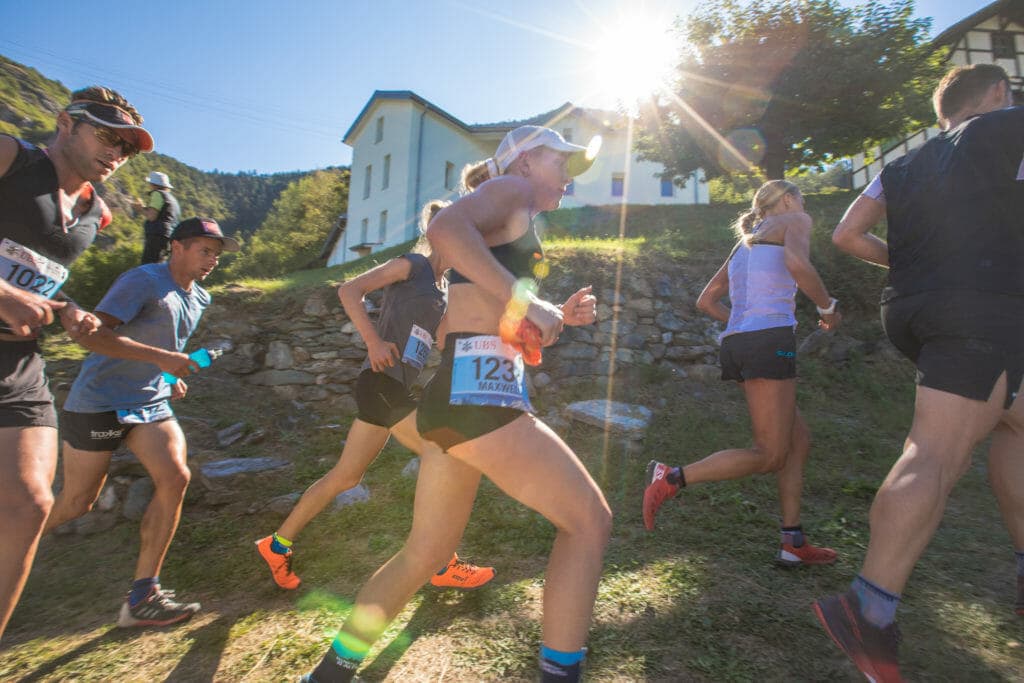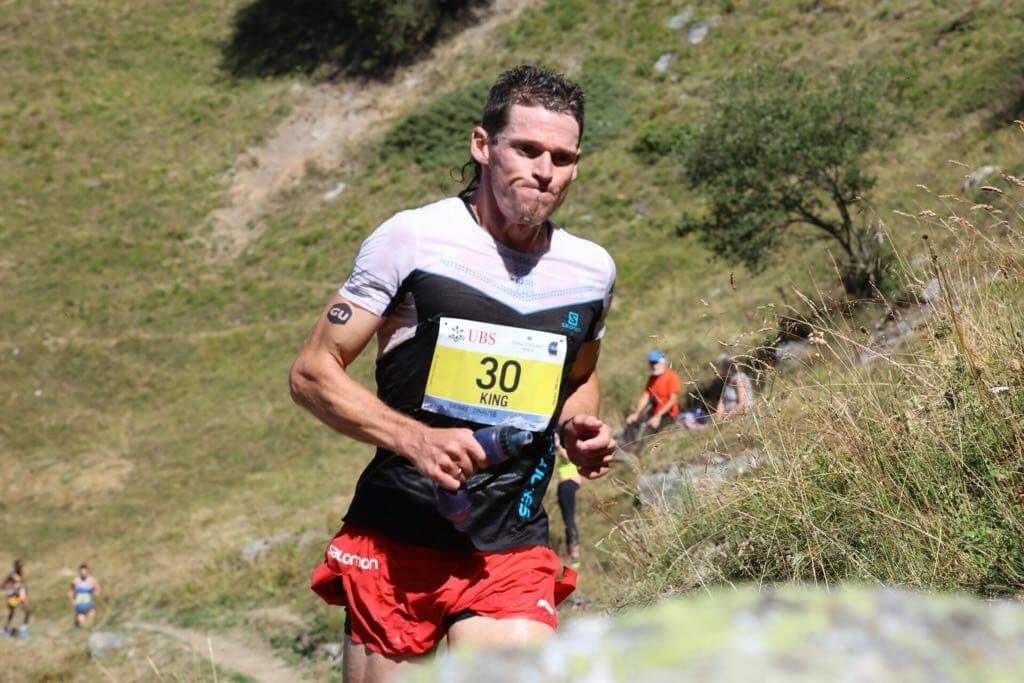
Getting back pre-race butterflies: thoughts from racing Sierre-Zinal
It was nice to feel the pre-race butterflies again. The familiar feeling – nerves rising from the pit of my stomach – came on strong as I walked towards the bib pick-up in Sierre, a small town in the Swiss canton of Valais that borders France and Italy.
The onset of pre-race jitters was both nerve-wracking and comforting; I hadn’t felt that same nervous excitement since my days of track and cross-country racing in college. Back then, racing was often linked to stress and anxiety; it wasn’t uncommon for me to have nightmares before a big race, or spend the whole night tossing and turning.
To tame my pre-race nerves in college, I often thought about how racing is a privilege. It’s a gift to be able to focus solely on racing for 16 or 17 minutes, to direct all my energy into pushing my body as hard as possible over a distance of 5 km on the track.

Since Sierre-Zinal is 31 km, I thought to myself that afternoon at the bib pick-up, it’s technically more than six times the privilege of a 5 km race on a track. That means six times more distance to appreciate the joy and challenge of pushing my body to the limit. Plus the thrill of tackling 8,000 feet of climbing, traversing grassy meadows and taking in views of five snow-covered distant peaks. Thinking through my nerves in this way – approaching the effort with joy rather than fear – made me appreciate the butterflies in my stomach.
As I was soon to discover, when it comes to racing Sierre-Zinal, privilege is certainly the right word.
The next morning, I stood huddled in the sub-elite starting block. As it was my first time in a competitive European trail race, I was placed in the second starting block behind 150 hand-picked elite runners who were invited by the race organization. As the 10-minute countdown began, I triple-knotted my laces and tightened my hair into a messy bun under my cap. With just two minutes to go, I looked around at the hundreds of bodies – runners of all different ages, from different competitive backgrounds, from countries all over the world – and I felt a smile spread across my face. Let’s go, I thought to myself. This is it. Mountain running at its finest. Nerves melted into giddy excitement in anticipation of the long route ahead. It felt like I was waiting in line to attend the year’s coolest party hosted by the world’s best trail runners.
At last, the final countdown began: “Troix, deux, un, allez!”, the gun sounded, and we were off. From the starting line, the first 2 km led up a gradual uphill section of road, which felt pretty speedy yet comfortable, thanks to my track background. As soon as we swooped onto the steep hiking trail ascent from the road, I expected those around me to start power hiking. Right around this bend we’ll hike, I thought. Oh, okay, nope, nope, we’re still going to run. That’s okay. Well, we can hike after this section of climbing. Oh, nope again. Okay, running is fine here too.
After about 10 minutes, however, nearly everyone had switched from uphill running to power hiking. I tried not expend too much energy, amazed at how fast some people around me were moving uphill. They made it look like a casual stroll, even as I craned my neck to look up as I tried to spot the next section of trail.

I was ready for the climb to be brutal, but it was even tougher than I had imagined. Rounding corner after corner, I would see the same sight: single-track weaving straight up through the trees. Even tougher was trying to gauge my pace against the women around me; the previous European trail races I’d competed in had just a few hundred competitors, so I was mostly alone or running alongside men after the first few kilometers.
Racing against women of this calibre was a whole different experience; the race was packed with many of the world’s elite female trail racers. Throughout the first half of the course, I played leap frog with many of them. They would pass me — seemingly without breathing — on the more vertical and technical sections of the course, but I would catch them when the trail flattened out and I could get my legs rolling. All the way until Hotel Weisshorn – an aid station situated 20 km in, and not far from the highest elevation point in the course – I kept an inner dialogue going: Relax and settle in, run the fast sections but chill a bit on the climbs. I knew that keeping my heart-rate under control and not thrashing my quads was essential, if I wanted to be able to really roll in the last 11 km of flat running and speedy descent.
While I did pretty well with saving my legs and keeping my breathing in check, there was one key factor that I didn’t fully consider: the importance of hydration and fuelling. There are seven aid stations along the Sierre-Zinal course, each supplied with water and electrolyte drinks. Along with three gels in my pockets, I assumed I’d be fine over 31 km as long as I drank at least a cup of water at every aid station and had a gel every hour. What I didn’t anticipate was how my body would react when, dehydrated and stressed from the effort of the 8,000-foot climb, I tried to prepare for the speedy section of downhill running by chugging two cups of water and two cups of an electrolyte drink called Isotar in about 30 seconds.
It was a rookie mistake.
As soon as I took my first steps back into running after leaving the aid station at Weisshorn, intense stomach cramping ensued. You’re fine, I told myself, over and over, as the cramps and nausea rose through my stomach in waves. Just stay positive. Just keep moving.
For the next 7km of the race, what should have been fluid, smooth flying over the stunning single track turned into a slow but steady jog. I clicked into tunnel vision: maintain a steady pace, don’t trip, try to breathe through your nose. I focused on continuing to cover ground, fearing that if I stopped completely my stomach cramps would tighten even more. Several speedy downhill runners flew by me, but I tried as hard as I could to not look back. Focus on your breath, I told myself. Relax your shoulders. Shake out your arms. The cramps will pass.
Luckily enough, with about 4km to go, the cramps began to ease up. I passed through the final aid station at Barneuza, skipped the fluids and instead splashed cold water over my head. The aches and nausea subsided as my body temperature dropped. I suddenly clicked from steady tunnel vision to competitive hunting mode: it was time to try to fly on the dive-bomb 3km descent.
I’m certainly not the fastest or the most skilled technical runner, but I figured I could pass a few people on the downhill if I could be just a little fearless. Flying down this section was intense. Bouncing off rocks and leaping over tree roots was so much fun that I almost forgot about the pain of my stomach cramping. The spirit of the crowd boosted my energy levels even more. Spectators lined the sides of the trail, ringing cowbells and cheering “Allez, Allez! Bravo!” as we half-ran, half-fell down the ridge.
I hit the paved road just outside Zinal with 500 meters to go and saw two women who were maybe only 10 seconds ahead of me. Here, four years of track-training – including weekly sessions of fast 150 meter sprints – really paid off. I sprinted down the final road section with everything I had, passing the two women and one man right at the finish. After 7km of handling intense cramping and nausea, it was an electric feeling to push myself in the final couple of hundred meters and fly across the line.

The magic of Sierre-Zinal is undeniable. With intense vertical, super speedy runnable sections, and a barrelling downhill, the race has something for everyone, no matter what kind of trail running you like. No one type of runner has an overwhelming advantage, and tactics can play a big role no matter what your finish time.
As I stood at the finish line and soaked in the energy of the elite runners around me, I almost forgot how much pain I’d been in only minutes earlier. Instead, I started thinking about how I much I want to come back next year, with more knowledge and experience, and a stomach trained for proper hydration and fuelling.
I’ve long considered racing a privilege, but Sierre-Zinal resets the standard to a whole new level. Truth be told, I’m already looking forward to next year’s pre-race butterflies.
More about Sierre-Zinal:
Why Sierre-Zinal is the Best Trail Race in the World
Pablo Vigil: The Man Behind a Remarkable Sierre-Zinal Record